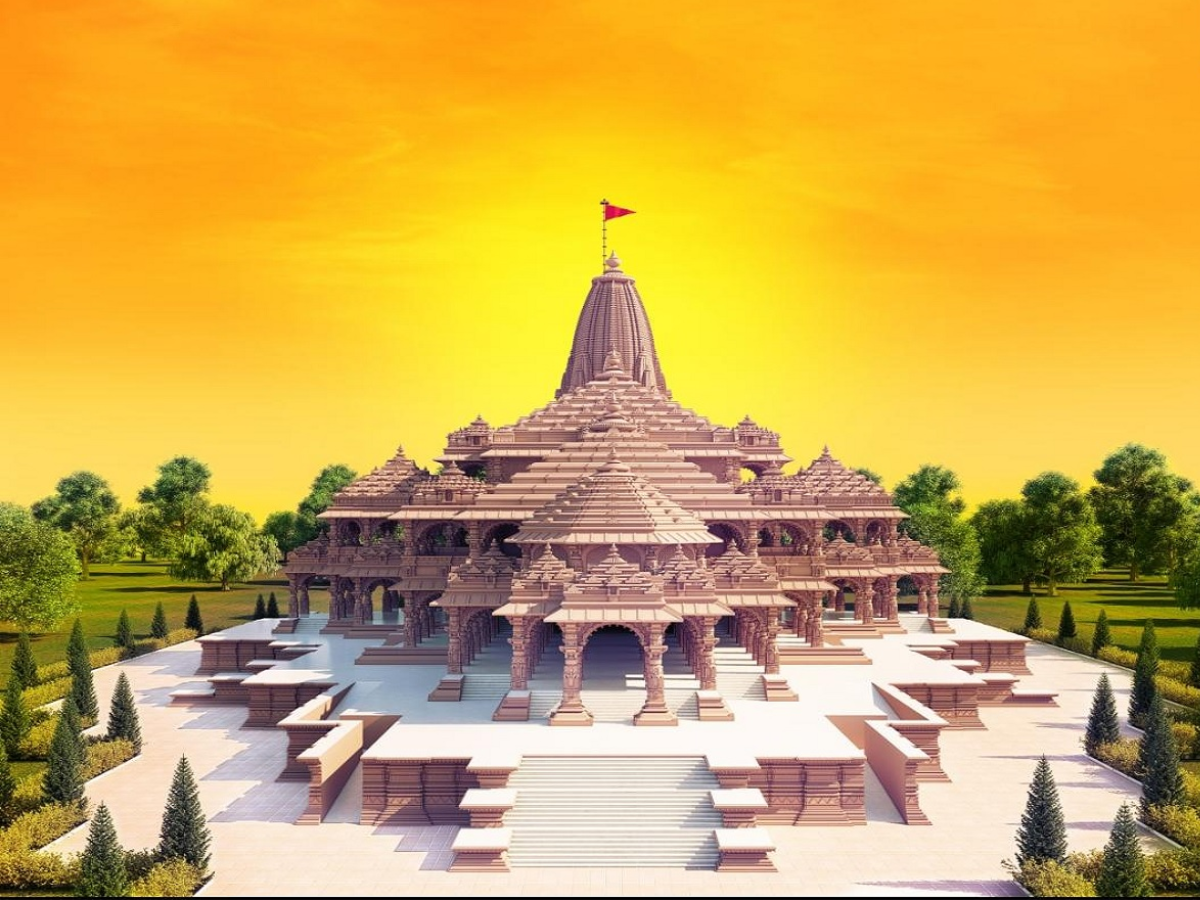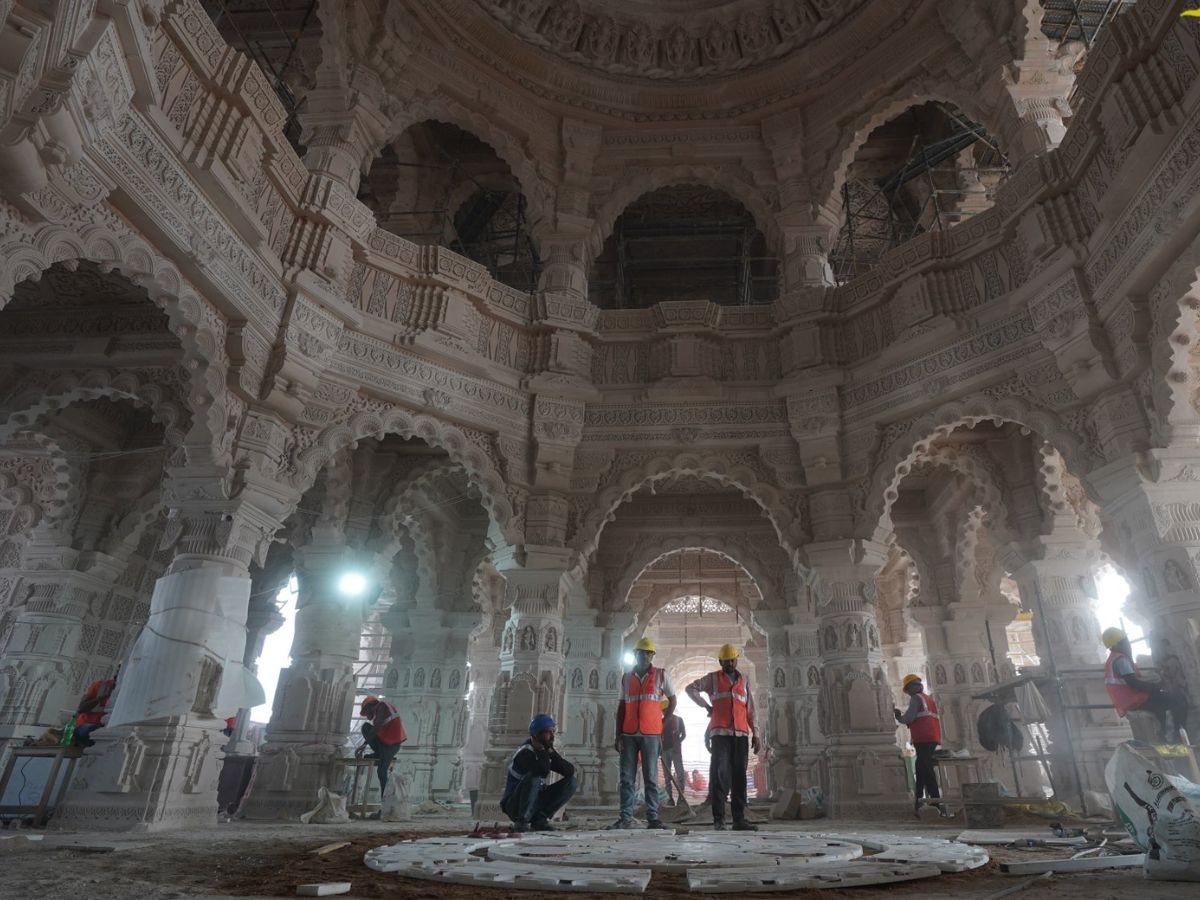Ram Temple in Ayodhya: All You Need to Know About Construction, History, Significance & Opening Date

views
Ayodhya is all set to welcome Lord Ram with Prime Minister Narendra Modi scheduled to participate in the consecration ceremony at the newly constructed Ram Mandir on Monday.
The Shri Ram Janmabhoomi Temple’s consecration ceremony will be done in the presence of Prime Minister Narendra Modi and other dignitaries including UP CM Yogi Adityanath, RSS chief Mohan Bhagwat, UP Governor Anandiben Patel, and president of the temple trust Mahant Nritya Gopal Das on January 22.
Over 7,000 people are attending the event including cricket legends Sachin Tendulkar and Virat Kohli, Bollywood superstar Amitabh Bachchan, and industrialists Mukesh Ambani and Gautam Adani.
Ram Temple Opening Date
The auspicious Pran Pratishtha of Lord Ram Lalla is taking place on the upcoming Paush Shukla Kurma Dwadashi, Vikram Samvat 2080, falling on January 22 (Monday) in the Vikram Samvat 2080 calendar.

Followed by the consecration ceremony of Ram Lalla in the sanctum sanctorum (Garbha griha) on January 22, the temple will be open for the devotees from January 23.
Brief overview of Ram Mandir
The Ram temple complex, built in the traditional Nagara style, will be 380 feet in length (east-west direction), 250 feet in width and 161 feet in height, Rai had said earlier. Each floor of the temple will be 20 feet high and have a total of 392 pillars and 44 gates. No iron is used anywhere in the construction of the temple.
Pictures taken this morning at Shri Ram Janmabhoomi Mandir site.श्री राम जन्मभूमि मंदिर परिसर में आज प्रातः काल लिए गए चित्र pic.twitter.com/MOaDIiS91Y
— Shri Ram Janmbhoomi Teerth Kshetra (@ShriRamTeerth) December 24, 2023
Temples made in the Nagara style are characterised by their towering spires or shikharas, intricate carvings, and symbolic representations. They have meticulous craftsmanship, as visible in the magnificent Khajuraho temples of Madhya Pradesh.
Ram Mandir Construction Journey
The original design for Ram Mandir was planned in 1988 by the Sompura family of Ahmedabad. However, it went through certain changes in 2020 in accordance to the Vastu shastra and the Shilpa shastras.
The Sompuras have contributed to the design of over 100 temples worldwide for at least 15 generations, including the Somnath temple.
The temple, built in an overall area spanning 71 acres, is divided into six parts, including the sanctum sanctorum and five pavilions—Gun Mandap, Rang Mandap, Nritya Mandap, Kirtan Mandap, Prarthana Mandap.
Details of Ram Temple Construction
The superstructure of the temple is being constructed by using carved Rajasthan sandstone from Bansi Paharpur in Bharatpur district. The carving and erection work of the sandstones have started and approximately 1,200 skilled technicians are engaged at mines and workshops in Rajasthan as well as at the Shri Ram Temple workplace, the trust said.
The quality of the stones and the workmanship of the carving is being supervised by experts from agencies including the National Institute of Rock Mechanics (NIRM) from Bengaluru, architect CB Sompura, and implementing agencies Larsen & Toubro Ltd (L&T) and Tata Consulting Engineers (TCE).
Key Features of Ram Temple Construction
- The three-storied temple is built in the traditional Nagar style with each wall measuring 20 feet. No iron is used in the construction of the temple anywhere.
- It has a length (east-west) of 380 feet, a width of 250 feet, and a height of 161 feet. The complex has a total of 392 pillars and 44 doors.
- Entry into the temple is from the east, ascending 32 stairs through the Singh Dwar. The main entrance to the temple will be the Lion Gate or the ‘Singh Dwar’, which is constructed using the Rajasthani sand pink stone in the Nagar style.
- Inside the Ram Mandir complex, there are proposed temples dedicated to Maharshi Valmiki, Maharshi Vashishtha, Maharshi Vishwamitra, Maharshi Agastya, Nishad Raj, Mata Shabri, and the revered consort of Devi Ahilya.
- At the four corners of the complex, there are four temples – dedicated to Surya Dev, Devi Bhagwati, Ganesh Bhagwan and Bhagwan Shiv. In the northern arm is a Mandir of Maa Annapurna and in the southern arm is a Mandir of Hanuman ji.
History and Controversy of Ram Temple
The construction of the Ram Temple began in 2020 after Prime Minister Narendra Modi laid the foundation stone on August 5. The construction of the temple started after the Supreme Court verdict in 2019, where the apex court in a historic judgement handed over the dispute 2.77-acre site in Uttar Pradesh’s Ayodhya town to the Hindu side for the temple construction.

The Muslims were given an alternative land to build a potential mosque. The five-judge Constitution bench, headed by Chief Justice of India Ranjan Gogoi, ruled unanimously that the spot, where frenzied right-wing mobs destroyed the four-centuries-old Babri Masjid in 1992, should be handed over to Ram Mandir trust to oversee the construction of a temple.
The highly anticipated ruling is the outcome of a legal tussle that began in 1950 — shortly after idols of deities were surreptitiously placed inside the structure — with Hindu groups saying the mosque had been built on top of a temple that had stood on the precise birthplace of Lord Ram, while Muslims contested this. However, the earliest recorded instances of violence over the land go back to the 1850s.
Significance of Ram Temple
The Ayodhya Ram Temple is considered to be an important pilgrimage sites for Hindus. It is believed to be the birthplace of Lord Ram and the construction of the temple is seen as a symbolic victory for the Hindu community, who had been fighting for the temple’s construction for decades.
The temple inauguration holds significance for Hindus worldwide as it is a milestone reached after the successful culmination of a decades-long movement for the construction of the temple.
Who is Attending & Who is Missing Ram Temple Pran Pratishtha?
The grand event will be attended by several leaders from across parties and several prominent personalities from film and television, industry, sports as well as seers and scholars.

Those who are attending include PM Modi, CM Yogi, RSS chief Mohan Bhagwat, LK Advani, JP Nadda and Eknath Shinde. The list also includes Bollywood megastar Amitabh Bachchan, Bollywood actor Akshay Kumar, actress Kangana Ranaut, cricketer Sachin Tendulkar, cricketer Virat Kohli, Yoga guru Ramdev, and industrialists Mukesh Ambai, Ratan Tata, and Gautam Adani. The trust has also invited actor Arun Govil who played the role of Lord Ram in the famous TV serial ‘Ramayan’ as well as Dipika Chikhlia, who played the role of Sita. Delegates from around 50 countries have also been invited for the consecration ceremony.
Congress leaders Mallikarjun Kharge, Sonia Gandhi and Adhir Ranjan Chowdhury have declined to attend the ceremony. Several others including Sharad Pawar, Mamata Banerjee, Akhilesh Yadav, Sitaram Yechury and Uddhav Thackeray will also skip the consecration event.
Ram Mandir Prasad
A group of confectioners from Varanasi and Gujarat have arrived in Ayodhya as they will be preparing sweet offerings for the devotees and all the participants who will be attending the historic consecration next Monday.
The renowned confectioners will be preparing 45 tonnes of laddus for the Pran Pratishtha ceremony. Around 1200 kg of laddus prepared using pure desi ghee will be offered as prasad to Lord Ram on the day of the ceremony.
One of the confectioners reportedly said, “the laddus are being made using pure desi ghee and will be offered as a prasad to Ram Lala on the 22nd of this month. We have been making laddus since January 6 and will continue doing so until January 22.”
Ram Mandir In Ayodhya FAQ’s:
Ram Temple Construction Cost
An estimated cost of Rs 1,800 crore will be incurred to build the Shri Ram Janmabhoomi Temple in Ayodhya.
What is the height of Ram temple in Ayodhya?
Ram Mandir in Ayodhya has the following dimensions: 380 feet in length (East-West direction), 250 feet in width and 161 feet in height.
Where is Ram temple located?
Ram Mandir is located in Ayodhya, Uttar Pradesh.
When will Ram Mandir Ayodhya be completed?
The final construction of Ram Mandir in Ayodhya will be completed by December 2024.
When Will Ayodhya Ram Mandir Be open for Public Visit?
The Ram Mandir will be open for public visit from January 23.
When is Ram Mandir Ayodhya opening?
The Ram Mandir in Ayodhya will be opened on January 22 after the Pran Pratishtha ceremony.
How to reach Ram Mandir Ayodhya?
The Ram Mandir in Ayodhya can be reached by road, railways or by air. The Maharishi Valmiki Airport in Ayodhya has recently been inaugurated connecting the temple city to the rest of India. PM Modi has also inaugurated Vande Bharat Express from Ayodhya to New Delhi.
How to donate Ram Mandir Ayodhya?
The donation to Ram Temple can be made through cheque, fund transfer or even UPI. The bank details of the trust is available on the Ram Mandir Trust website srjbtkshetra.org/donation-options.
Which Company constructed Ram Mandir?
Larsen and Toubro (L&T) is involved in the construction of the Ram Temple in Ayodhya.


















Comments
0 comment